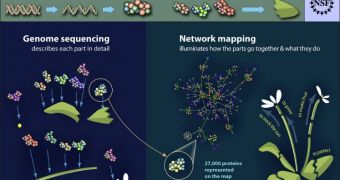Researchers announce the creation of the first systematic interactome, a map of all the interactions that occur between proteins in a plant species. The mustard plant Arabidopsis thaliana – commonly used in research – was selected for this research.
The plant contains more than 27,000 proteins, and researchers accounted for the interactions involved 2,774 individuals molecules. A total of 6,205 interactions were inserted in the new research tool
This systematic network map of interactions should help botanists in the same way studying the genome of rodents led to the creation of the standard lab mouse. The new map provides data on twice as many interactions as any previous instrument of the same time.
Details of the effort, which was conducted by an international team of scientists, appear in the July 29 issue of the top journal Science. The group was called Arabidopsis Interactome Mapping Consortium.
Their investigation was partially funded by the US National Science Foundation (NSF), and included numerous research groups, institutes and universities around the world. Data obtained from this map could aid experts in developing ways of boosting plant growth and disease resistance.
Such advancements are becoming increasingly critical around the world, as Earth's population increases, and food supplies dwindle. Further increases in populations could lead to a collapse of food chains, if more productive plants are not created.
The new interactome relies heavily on a genome sequence of Arabidopsis, which was completed a couple of years ago. What it provides is a parts list of all genetic components inside this small plant.
“This starts to give us a big, systems-level picture of how Arabidopsis works, and much of that systems-level picture is going to be relevant to--and guide further research on – other plant species, including those used in human agriculture and even pharmaceuticals,” says Joseph Ecker.
The expert – who holds an appointment as a biologist at the Salk Institute – is a senior member of the Consortium. He admits that the new map covers only a mere 2 percent of all protein interactions in the Arabidopsis plant.
In the future, the work will continue, until researchers finally have a comprehensive view of how this critically-important organism works. In the meant time, scientists will continue to scans the already-deciphered portion of the genome, looking for ways to translate the data into practical applications.

 14 DAY TRIAL //
14 DAY TRIAL //